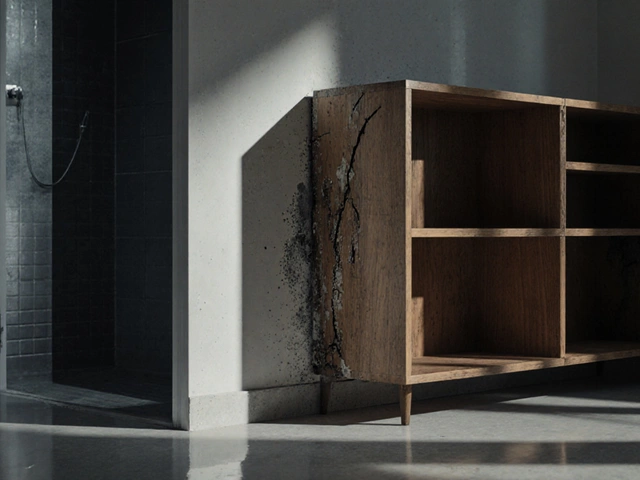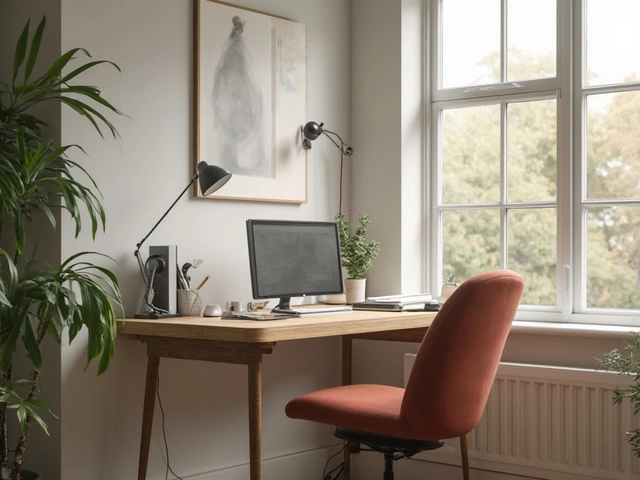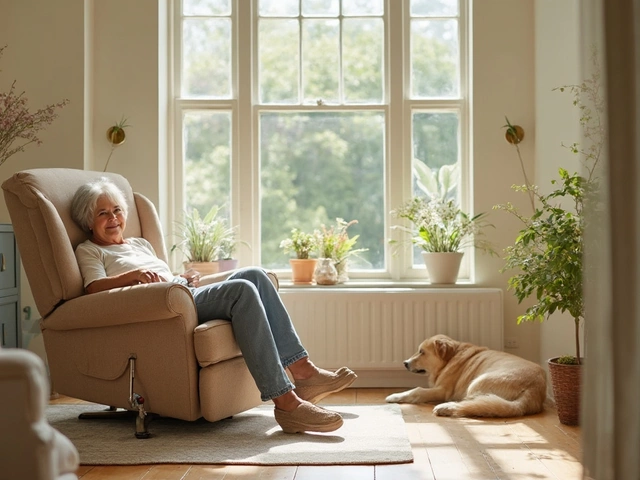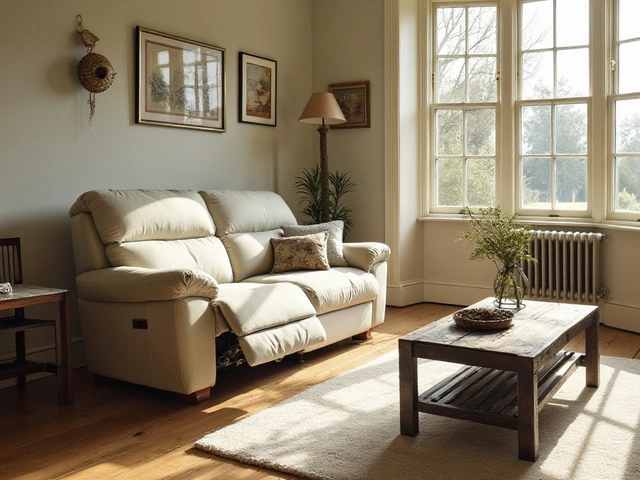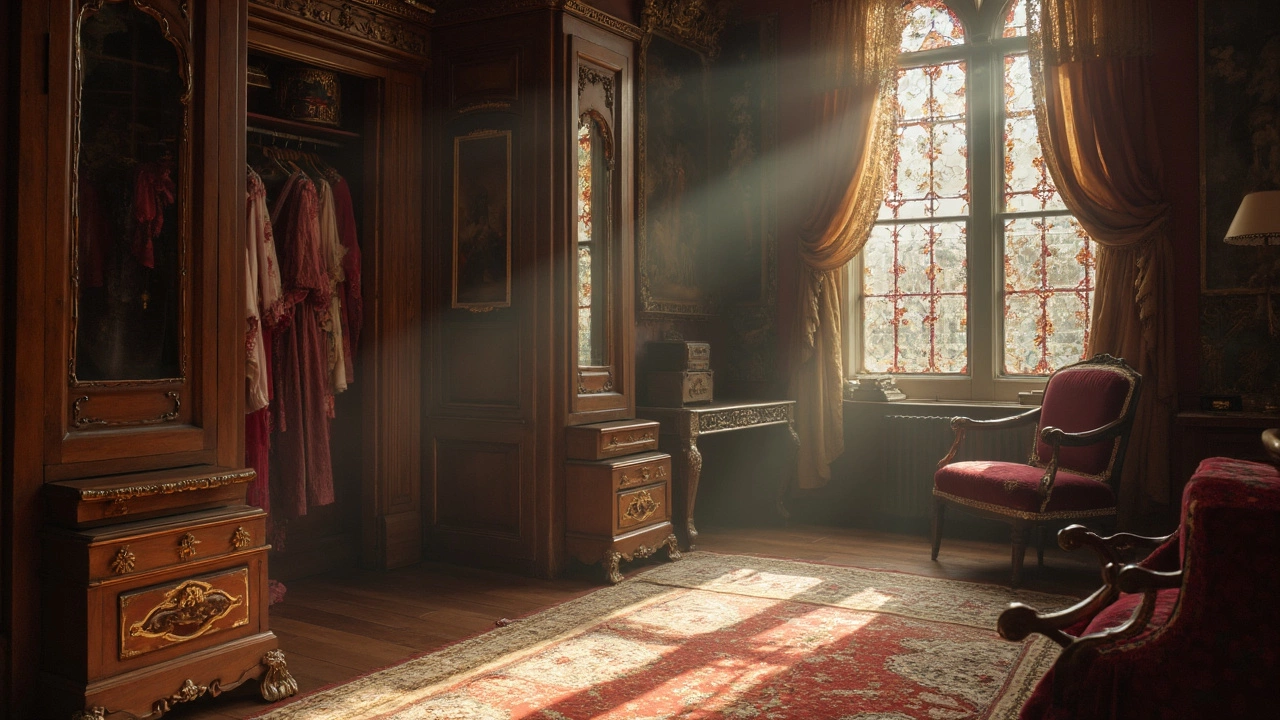 3
Jun,2025
3
Jun,2025
Ever heard someone mention a 'royal wardrobe' and wondered if it’s just a fancy closet or something more grand? You’re not alone. The phrase doesn't just mean an expensive clothing rack; it actually traces back to literal rooms and special furniture pieces from royal households, where keeping clothes was a big deal—think security guards for robes and jewels, not just hangers.
If you’ve ever been confused by the difference between an armoire, a wardrobe, or something like a 'Gentleman’s Chest,' don’t sweat it. There’s a reason these names exist, and sometimes the origins are way older than you’d guess. Woodworkers, palace staff, and even royalty themselves influenced what we call these storage spots today. So, if you’re thinking of updating your own wardrobe, or just want to know what Tigger would nap in if he lived in Buckingham Palace, you’re about to find out what’s really behind the name.
- What Does 'Royal Wardrobe' Actually Mean?
- A Glimpse into History: Where the Term Comes From
- Types of Royal Wardrobes and Their Real Names
- Royal Wardrobe vs. Your Closet: What's the Difference?
- Ways to Bring Royal Style Home
- Fun Facts and Tips about Wardrobes
What Does 'Royal Wardrobe' Actually Mean?
If you picture gold-trimmed cabinets bursting with crowns, you’re kind of on the right track, but the term ‘royal wardrobe’ started as something way bigger than a piece of furniture. In medieval England, the ‘Royal Wardrobe’ was actually an entire department in the royal household. They handled not just the king’s clothes, but royal treasures and supplies too. You heard that right—a whole official team dedicated to outfits, jewels, linens, and storage. Even budgets and accounting for royal spending came under their umbrella.
By the 13th century, there was a real place called the Wardrobe Office, complete with rooms, staff, and enough paperwork to make anyone dizzy. Royals, especially in England, relied on it like today’s celebrities lean on their stylists and assistants. According to historian David Carpenter:
"The Wardrobe...grew into the king’s chief department for the management of his affairs, trusted to supply goods, track accounts, and even fund wars."
Most folks today use ‘royal wardrobe’ to talk about historic dressers, giant armoires, or anything that looks like it could belong in a palace. But the heart of it was always storage and management—making sure the important stuff was safe and always ready to go.
So what actually made the Royal Wardrobe stand out? Here’s a quick comparison to regular household storage at the time:
| Feature | Royal Wardrobe | Average Home |
|---|---|---|
| Security | Guards, locked chests | Simple wooden chests |
| Staff | Dedicated clerks/keepers | Self or family |
| Inventory | Detailed records | Rarely documented |
| Contents | Clothes, jewels, money, linens | Basic clothes, bedding |
| Room Size | Separate rooms/offices | Small trunks or closets |
So, when you hear 'royal wardrobe,' think a lot bigger than one elaborate cabinet. It’s more about how royals organized, protected, and displayed their stuff—with style and some serious security. If you want your own closet to feel a bit royal, it’s less about being flashy and more about staying organized and keeping your prized items in great shape. That’s what set the royal wardrobe apart from the average storage spot.
A Glimpse into History: Where the Term Comes From
The idea of a 'royal wardrobe' didn’t start as a piece of fancy furniture. Back in medieval England, “The Royal Wardrobe” was actually an entire department in the king’s household. They weren’t just folding clothes—they were managing royal costumes, expensive fabrics, jewels, and even money. The Wardrobe staff kept records of everything, and sometimes the department was packed with more valuables than the king’s treasury itself.
According to the British Library, “The wardrobe was not just a store, but the controller of financial and household administration for the English monarchy from the 12th to the 17th century.”
“The Wardrobe was, for many years, at the heart of royal government, responsible for keeping not only the king’s clothing, but the wealth that clothed the monarchy in power.” — British Library
This department had its own building near the Tower of London and played a bigger part in royal life than people realize. Kings would keep their ceremonial robes here, but you’d also find weapons, official documents, and gifts from other royal families. The name stuck, and over time, as actual chests and cabinets became more common for personal clothing, people started using 'wardrobe' for big, often ornate cabinets in their own homes.
So, when you hear 'royal wardrobe' today, it packs in hundreds of years of history—part furniture, part royal power. No wonder these pieces turned into household staples and still feel a bit special, even if you’re just tossing your everyday clothes inside.
You probably won’t find a hidden stack of gold in your royal wardrobe at home, but the name’s got roots in a slice of history packed with drama, style, and even the occasional secret.
Types of Royal Wardrobes and Their Real Names
If you’re thinking a royal wardrobe is just a normal cupboard with a fancier handle, that’s not quite right. Royals have used all kinds of storage, each with its own name and specific job. Back in the Middle Ages, the 'Royal Wardrobe' wasn’t even a piece of furniture. It was an actual department of the king’s household in England, responsible for storing clothes, jewels, and fancy stuff for the crown. Now, let's break down the most well-known types you’ve seen in palaces and historic homes:
- Wardrobe: This one actually started as a room or small building where royal garments were kept under lock and key. Later, it turned into a standing closet with doors. Simple enough, but in big houses, these could be full walk-in rooms.
- Armoire: A big, often decorative cabinet that came from France. You’ll see armoires in a lot of royal bedrooms because they hold more than just clothes — linens, valuables, even weapons sometimes. They’re almost always made of wood, and the fancier the carving, the higher up the owner probably was.
- Press Cupboard: Don’t let the word 'cupboard' fool you. In Tudor England, a press was a tall cabinet with doors, often used for storing linens or ceremonial robes. Kind of a multi-purpose storage piece for special occasions.
- Gentleman’s Wardrobe or Gentleman's Chest: Royals and nobles with a lot of uniforms or suits used these. They’re deeper and have drawers plus hanging space, so everything stays neat.
- Almery (or Ambry): If you’ve ever seen a church wardrobe for vestments, that’s an almery. In castles, it could be a locked stone or wood cupboard for religious robes or treasures.
These storage pieces have some real history behind them. As late as the 1500s, English royals kept their robes in special places called 'robes’ chambers,' staffed by people who recorded every doublet and sash. In France, it was typical for the king’s armoires to be so ornate that they’d show off the skill of the best craftsmen — some even had secret compartments for valuables.
| Name | Origin | Main Use |
|---|---|---|
| Wardrobe Room | England, 13th c. | Storage of royal clothing, fabrics, and jewels |
| Armoire | France, 17th c. | Clothes, valuables, linens |
| Press Cupboard | England, 16th c. | Formal robes, linens, plate |
| Gentleman’s Chest | Europe, 18th c. | Uniforms, daily clothing, accessories |
| Almery | Britain, Medieval | Church or ceremonial garments |
So, while today most of us are fine with a built-in wardrobe or sliding closet, the royals had very specific ways to keep everything sorted. It’s pretty cool to realize that what you call an armoire or wardrobe has roots in centuries of royal habits. Even now, furniture dealers and interior designers still use these old-school names to up the style factor. If you want your bedroom to feel a little more castle-like, looking for these pieces is a great place to start. And here’s a tip: if something is called a royal wardrobe in a store, check if it matches any of these classic types — that way you know you’re getting some real history, not just a fancy name.
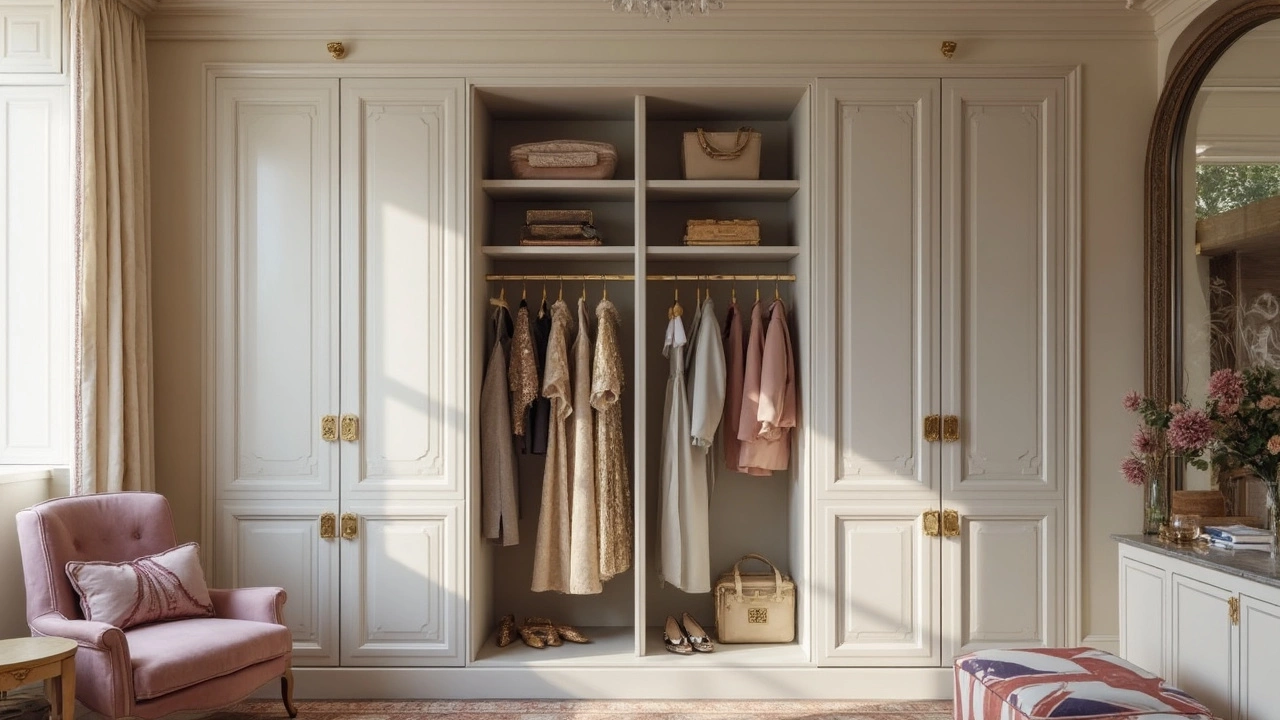
Royal Wardrobe vs. Your Closet: What's the Difference?
Let’s get this straight—your everyday closet and a true royal wardrobe aren’t playing in the same league. Historically, the royal wardrobe was way more than a place to keep shirts and socks. Back in medieval England, the Royal Wardrobe actually referred to a whole department, complete with its own staff and record books. They handled not just clothing, but also fabrics, ceremonial robes, jewelry, and sometimes even treasury items. This was serious business, not just storage.
Here’s what set the royal wardrobe apart:
- Security: Royal wardrobes were often locked rooms, guarded to keep out curious hands. Imagine needing a security guard just to grab your jacket!
- Size and Scope: Some royal wardrobes took up entire wings of a palace. Think: clothing for every possible weather, event, and ceremony—enough to make your local department store blush.
- Management: Royals had staff called Wardrobe Keepers or Yeomen to manage the collection, keep records, and handle laundry. Not many of us have a closet team—even Tigger just supervises from the laundry basket.
- Contents: We’re talking furs, silks, crowns, gowns, weapons, and sometimes state documents. Your closet has coats and shoes; theirs had ermine capes and coronation regalia.
Let’s put the royal wardrobe side by side with a modern closet for a quick comparison:
| Royal Wardrobe | Modern Closet | |
|---|---|---|
| Size | Whole rooms, even multiple floors in big palaces | Usually a small room or built-in cabinet in a bedroom |
| Security | Locked doors, guards, strict access | Maybe a door or sliding panel—guard cat optional |
| Staff | Professional wardrobe keepers, assistants, clerks | You (and maybe a helpful roommate or partner) |
| Contents | Robes, jewels, ceremonial gear, historical records | Everyday and occasional wear, shoes, maybe a box of memorabilia |
| Purpose | Store, display, protect treasured and official items | Hold your regular outfits and give you a place to hide holiday gifts |
So, unless you’ve got a secret room stuffed with velvet robes and a butler waiting for you to pick out what to wear, your closet is probably closer to IKEA than Windsor Castle. But hey, at least you don’t have to fill out a requisition form just to grab your favorite hoodie.
Ways to Bring Royal Style Home
If you want your own space to have a little royal flair, you don’t need to live in a palace or spend a fortune. Even regular wardrobes can get a regal vibe with a few smart choices. Here’s how you can do it without any drama or mystery.
- Pick Smart Materials: Royals have always gone for quality wood. Oak, walnut, and mahogany are the typical picks because they're durable and look upscale. You don’t have to buy antiques—these days, you can find dressers and wardrobes with a similar look at most furniture stores.
- Add Crown Moldings or Trim: A lot of historical royal wardrobes have some sort of detailed woodwork, like cornices along the top. You can actually buy stick-on molding at a hardware store and DIY the look on your existing wardrobe.
- Go for Fancy Handles: Swap out boring handles or knobs for brass or crystal ones. It’s one of the fastest and cheapest tricks to give your wardrobe a royal touch.
- Color Counts: Rich, deep colors like navy, royal blue, emerald green, or burgundy are a nod to royal tastes. If you feel brave, painting your wardrobe or the wall around it in one of these tones can make things look royal fast.
- Mirrors and Lining: Royal wardrobes often had mirrors inside or velvet lining. You can glue a mirror to the inside of the door and stick adhesive velvet to drawers or shelves for the same effect.
Modern wardrobes inspired by royalty are surprisingly popular. According to a 2024 survey by the International Home Furnishings Association, 34% of new furniture buyers wanted at least one 'statement' piece that’s classic or vintage-inspired. Many end up choosing wardrobes because they combine storage with style—the best of both worlds.
| Feature | Description |
|---|---|
| Crown Molding | Decorative trim at the top, even on flat-pack wardrobes |
| Classic Materials | Woods like oak or mahogany, sometimes just a veneer |
| Vintage Handles | Brass, crystal, or imitation antique hardware |
| Secret Compartments | Small hidden drawers or jewelry trays |
| Inside Mirrors | Mirror panels on inside doors for extra function |
If you shop secondhand or check out estate sales, you can sometimes find real royal-style pieces for less than you’d expect. And don’t forget: even Tigger knows a closet feels fancy with comfy lining inside.
Fun Facts and Tips about Wardrobes
If you think wardrobes are just plain old storage, think again. Some of the world’s most famous wardrobes have hidden stories, clever designs, and even secret compartments—seriously, there’s more to them than meets the eye.
First up, here are some fun facts you probably haven’t heard before:
- The original royal wardrobe in medieval England was actually a whole department. Instead of just being furniture, it managed the king’s clothing, jewels, and even some cash—kind of like an ancient version of a walk-in safe and wardrobe combined.
- The oldest known wardrobe dates back to the 14th century and was found in a French castle. That piece looked nothing like the big, mirrored wardrobes from the 1800s—think chunky planks, thick doors, and huge locks. Royals cared about their coats staying hidden and safe.
- Queen Victoria owned a wardrobe made from rare Indian wood and had secret drawers—she supposedly hid letters and locked away mementos in them.
- The term "armoire" is French, and it stuck in English after nobles started showing off their imported furniture. Armoires are usually fancier than regular wardrobes, with carvings and bold hardware.
If you want to boost your own storage space, try these tips for a wardrobe with a regal twist:
- Use cedar blocks or sachets to keep moths away and keep things smelling fresh. Royals have done this for centuries, and it still works.
- Get creative with add-on shelves or hanging organizers. Even basic wardrobes can look and function like high-end furniture with some cheap upgrades.
- Install simple puck lights or stick-on LED strips inside. It makes finding your favorite shirt easier and feels way more luxe.
- Don’t underestimate the power of a nice set of handles or knobs—swap them out for metal, glass, or even antique hardware for a kingly touch.
Here’s a snapshot on wardrobe sizes, past and present:
| Century | Average Height (cm) | Main Material | Common Feature |
|---|---|---|---|
| 14th (Medieval) | 150 | Oak | Lockable doors |
| 19th (Victorian) | 200 | Mahogany | Mirrored doors |
| 21st (Modern) | 220 | Engineered Wood/Plastic | Lighting, modular shelves |
Don’t forget, the right wardrobe is about more than just looks—function and a bit of personality make dressing less of a hassle. No need for hidden chambers or diamond handles (though, hey, if you can, why not?). Even Tigger would approve of a wardrobe that lets you dig out your favorite sweatshirt without the fuss.
